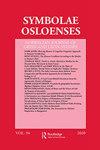Some New Vergilian Loci and Second Thoughts on Old Ones*
IF 0.1
3区 历史学
0 CLASSICS
引用次数: 0
Abstract
I. The text of Ecl. 3.100–102 is discussed and evaluated: quam is defended against quom and Cartault’s proposal [1897. Étude sur les Bucoliques de Virgile. Paris: Armand Colin] Hisce cutes – not adopted by editors and hardly visible in later apparatus critici, but recommended as worthy of attention by Heyworth [2015. “Notes on the Text and Interpretation of Vergil’s Eclogues and Georgics.” In Virgilian Studies. A Miscellany Dedicated to the Memory of Mario Geymonat [Studia Classica et Mediaevalia 10], edited by H.-C. Günther, 195–249. Nordhausen: Traugott Bautz] – is both brilliant and necessary. II. Based on grammar and context the abl. risu at Ecl. 4.60 is taken as modal: “Begin, little boy, to recognize (get to know) your mother with your smile”; then the final lines (62–63) must be restored to comply with Quintilian’s figura in numero (9.3.8) as qui risere (plural) followed by hunc “such a one” (singular); this change in number is shown to be in accordance with the use of a generalizing hic to denote quality. – III. At G. 2.22 I propose quos … vias construing reperire with two accusatives. – IV. At G. 2.266–268 I furnish parallels for similem … et as “like to” supporting Heyworth’s mutata … semina. – V. Rejecting my earlier position on A. 9.462–464 I now give a repentant vote in favour of Conte’s punctuation [2009. P. Vergilius Maro. Aeneis [Bibliotheca Teubneriana]. Berlin: De Gruyter] while at the same time adding an argument in its favour.一些新的维吉尔轨迹与对旧轨迹的再思考*
I.Ecl。对3.100–102进行了讨论和评估:针对quom和Cartault的建议[1897。维吉尔布科利克河畔的Étude。Paris:Armand Colin]Hisce cutes——没有被编辑采用,在后来的器械评论中也几乎看不到,但被Heyworth[2015推荐为值得关注。《维吉尔的《神学与几何学》的文本与解读札记》,载于《维吉尔研究》。献给马里奥·吉莫纳特记忆的杂集[Studia Classica et Mediaevalia 10],H.-C.Günther编辑,195-249。Nordhausen:Traugot-Bautz]——既出色又必要。二、基于语法和上下文的abl。在Ecl。4.60作为语气:“开始吧,小男孩,用你的微笑认出(了解)你的妈妈”;则最后几行(62–63)必须恢复,以符合Quintilian在数字(9.3.8)中的图形,即qui risere(复数),后跟hunc“such a one”(单数);数字的这种变化被证明是根据广义hic来表示质量的使用III、 在G.2.22中,我提出了quos…vias用两个宾格来解释repaireIV、 在G.2.266–268中,我提供了类似的…et作为“喜欢”来支持海沃斯的突变…神学院五、我拒绝了我先前对A.9.462–464的立场,现在我投了一张悔过票,赞成孔特的标点符号[2009。P.Vergilius Maro。《埃涅阿斯纪》。柏林:De Gruyter],同时添加了一个对其有利的论点。
本文章由计算机程序翻译,如有差异,请以英文原文为准。
求助全文
约1分钟内获得全文
求助全文

 求助内容:
求助内容: 应助结果提醒方式:
应助结果提醒方式:


